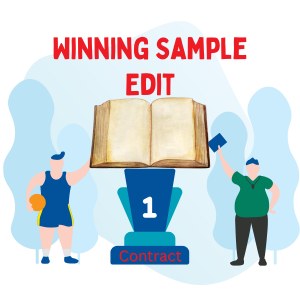How to Create a Winning Sample Edit Now
- Editors School Admin
- 0
- Posted on

If you’re a freelance editor, there’s a good chance you’ll be asked by most prospects to do a sample edit. And the stakes are high: a winning sample edit can land you a dream project, while a weak or misaligned sample can lead to confusion, ghosting, or underpaid work.
The good news? Creating a winning sample edit doesn’t require years of experience. It just requires clarity, strategy, and a thoughtful approach.
In this post, we’ll walk you through how to create a sample edit that highlights your skills, positions your value, and helps you work with clients who are the right fit for you.
What a Sample Edit Is and When You Need One

Defining a Sample Edit
A sample edit is a short portion of a manuscript—usually 500 to 1,000 words—that you edit to demonstrate your style, approach, and fit for the project. Think of it as a first date between you and the author. A sample edit shouldn’t be a full chapter, and it certainly isn’t the full book (yes, I’ve been asked by several different authors to edit an entire book manuscript “as a sample”).
When to Offer a Sample Edit
You may want to provide a sample when:
- The author is serious but still deciding
- You’re one of several editors being considered
- The manuscript is in a genre you don’t often work in
- You want to demonstrate how your edit adds value
Some editors offer these for free. Others charge a nominal fee and apply the cost to the full project if booked. You get to choose.
Goal of a Sample Edit
Your job is to show how you think and how you work with authors. A winning sample edit demonstrates your editorial judgment, your communication style, and your respect for the author’s voice as well as your technical skills of catching errors.
You’re not just marking up a page. You’re giving the author a small taste of what it’s like to work with you, so focus on clarity, consistency, and tone as much as corrections.
Step-by-Step: How to Create a Winning Sample Edit
1. Ask to see the full manuscript first.
The first thing to do is to ask for the entire manuscript. You don’t need to read it all, but you do need to get a sense of things like this:
- The project’s overall quality
- The consistency (or lack thereof) between chapters
- How representative the sample is
Without the full manuscript, you’re quoting blind. That can lead to poor scoping, undercharging, or taking on a project you’re not actually the right fit for.
2. You choose the sample; the author does not.
This is critical.
Authors will often choose their strongest, cleanest, most polished chapter or section to send an editor as a sample. Maybe the reason is innocent: thinking it will impress you. But that section is not representative of the manuscript as a whole. If you base your estimate and approach on the best part of the book, you’ll be unpleasantly surprised later by how much more work the whole thing needs.
That is bad.
Worse is when the author’s reason for sending you the best segment of the book is not innocent. Some do it not to impress you but to rob you. Oh, they probably don’t think of it in those terms, but that’s what it is. They hope they can get a low bid from you on the project. Once the contract is inked, they send the full manuscript, and you’re stuck working for much less than you would have charged had you known the truth.
Worst is when authors rob a dozen other editors along with you. Some authors deliberately send different portions of the manuscript to different editors under the false pretense of looking for an editor to hire.
One of the editors receives and edits Chapter 1, another gets Chapter 2, and so on. Some editors will only do a few pages and refuse to do a full chapter for a sample edit, so the author will just find a few more editors to con—and yes, that’s a strong word. It is accurate. Each editor of course wants to do a winning sample edit and help the author.
The author is hoping to get the entire book manuscript edited for free. They are conning editors and have no intention of hiring any of you.
The Free Frankenedit
This swindle is called “getting a Frankenedit,” a term first used in this context by our founder in a forum post in 1999. The tactic leaves editors unpaid, and because each editor’s work output is different—wildly so if some of them are developmental editors, some are line editors, and the rest are copy editors—it leaves the authors with an inconsistently edited manuscript.

Authors who pull this con know these facts and do not care, justifying their behavior by saying they don’t earn enough from the sales of their books to hire an editor. One has to wonder if the Frankenedits they obtain contribute to their problem.
Protect your time and your integrity. Always choose the section yourself to do your winning sample edit on. Ideally, select it from the middle of the manuscript. Explain to the author why you do it that way.
3. Clarify what type of editing you’re doing in the sample.

Are you doing a copyedit, a line edit, or a developmental critique?
Make sure the type of edit matches the scope the author is hiring for. Don’t deliver a critique when they’re expecting a copy edit sample, or vice versa. That won’t result in a winning sample edit. Clear communication curtails confusion.
If they don’t know what kind of editing they need, ask thoughtful questions so you can figure it out, or offer to make a recommendation after you review the full manuscript and determine what type(s) of editing the book needs. This is one reason editors must see the entire manuscript.
4. Show your skill.
Use Track Changes in Microsoft Word, or Suggesting Mode in Google Docs. Add brief comments in the margins when context is helpful. Fix everything that falls under the type of editing you do. I’ve seen editors complain that they didn’t have a winning sample edit when they only corrected one kind of error or one instance of each of a few types of mistakes. The author isn’t going to assume that you’ll catch and correct all of the errors in the manuscript if you can’t even catch them in the 500-word sample edit!
5. Summarize your thinking.
Include a short, friendly summary with your sample edit. This could go in the body of an email, in a document header, or in a comment at the beginning or end of your sample edit.
Touch on these:
- What kind of edit you provided
- What stood out about the writing (strengths + suggested improvements)
- How you’d approach the project as a whole
This shows that you’re thoughtful, communicative, and already invested in helping the author succeed.
What Clients Look for in a Winning Sample Edit

The author may say they “just want to see your style,” but this is what they’re really asking:
- Do you respect their voice?
- Do you understand their goals?
- Do you offer clarity without condescension?
- Do you feel like someone they want to work with?
They’re not just reviewing your edits. They are auditioning a relationship with you.
Common Mistakes That Sabotage Sample Edits
Avoid these pitfalls if you want your sample edit to leave a strong impression:
- Overediting to impress, which can erase the author’s voice
- Using the wrong type of editing for what the client needs
- Neglecting to explain your approach
- Sounding too harsh or too vague
- Allowing the author to select the sample (already covered above)
Great sample edits strike a balance between skill, voice, tone, and professionalism.
Conclusion
A winning sample edit isn’t about being perfect. It’s about showing up as a thoughtful, capable professional who knows how to make a manuscript better and who communicates clearly with clients.
Editors who take a strategic approach to sample edits land more projects that are good fits, build trust, and avoid burnout from mismatched work.
5 FAQ on Winning Sample Edits

Q: Should I charge for doing sample edits?
A: That’s up to you. Free samples can be useful for marketing, but some editors charge a small fee or apply the cost to the project if booked.
Q: What if a client disappears after I do a sample edit?
A: It happens. Chalk it up as a learning experience and move on. Every sample builds your skill.
Q: Can I reuse a sample edit as a portfolio piece?
A: Only with permission. If not, create anonymized samples based on common manuscript issues.
Q: How much time should I spend on a sample edit?
A: Keep it to 30–60 minutes. You’re not doing free labor—you’re demonstrating your value and fit.
Q: Can I skip doing sample edits altogether?
A: You can—but offering one strategically (on your terms!) can often help convert hesitant clients and build trust.
TL;DR:

A winning sample edit is your best tool for showing how you work—and what it’s like to work with you. Choose the excerpt yourself, edit with intention, and always keep the client’s voice and goals in mind.
Call to Action

Want to master the art of the sample edit—and learn how to set boundaries, scope projects, and price your work like a pro?
👉 Join Editors School to build a confident, sustainable editing career—one sample (and system) at a time.